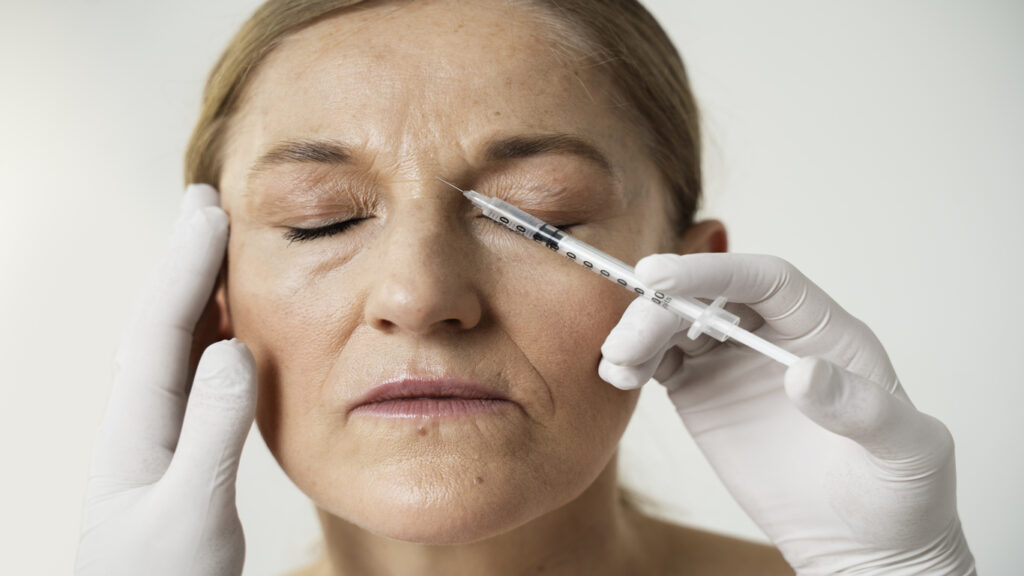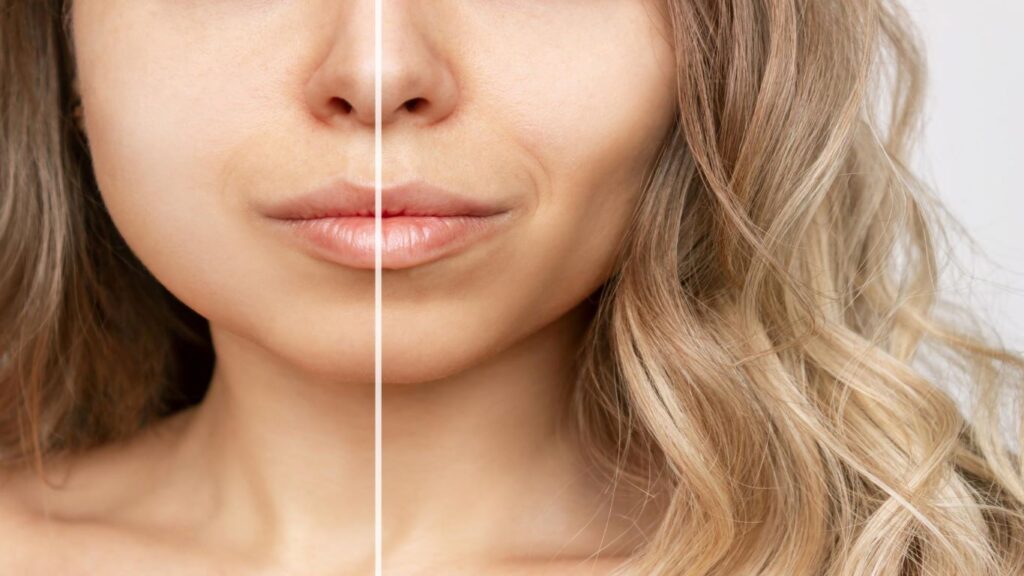Table of Contents
As we age, the skin, fat, bones, and muscles of our faces thin and sag due to the natural aging process. The skin’s collagen and elastin levels are low, making it less dense and resilient. The aging process causes the production of moderate to severe fine lines, folds, wrinkles, nasolabial folds, and marionette lines. They also induce volume loss, which needs soft tissue augmentation. Dermal fillers can enhance the appearance of moderate to severe skin aging by lowering, correcting, and even reversing some of the aging process’s alterations. In this post, we’ll go over calcium hydroxylapatite injection (CaHA), a dermal filler approved by the US Food and Drug Administration that can help you look younger.
What Is calcium hydroxylapatite injection?
Calcium hydroxylapatite injection (CaHA), often known as Radiesse, is a popular biocompatible dermal filler used for face and hand rejuvenation. Calcium hydroxylapatite (CaHA) is a sterile, gel-like, latex-free soft tissue filler with a lengthy track record of safety and efficacy and a low incidence of side effects. By reversing the signs of aging, a calcium hydroxylapatite filler treatment can offer you a natural-looking, youthful appearance. It can treat wrinkles and creases ranging from moderate to severe. It can also help you with nasolabial folds, marionette lines, and other facial soft tissue augmentation.
Calcium hydroxylapatite injection (CaHA) is a one-of-a-kind filler because it performs two functions. First, CaHA replaces volume loss, essential for nasolabial fold repair. Second, it increases collagen formation, correcting moderate to severe facial wrinkles, folds, and marionette lines. Collagen is a protein that serves as the primary structural component of many tissues in the body, including the skin. The skin’s collagen decreases with age, resulting in mild to severe face wrinkles. Injectable calcium hydroxylapatite CaHA improves the appearance of your skin by replenishing collagen. CaHA dermal filler provides rapid volume restoration for facial soft tissue enhancement. It also increases volume for a more extended period by stimulating collagen formation.
What is calcium hydroxylapatite Injection best used for?
The development of moderate to severe face creases and folds, volume loss, collagen and elastin breakdown, tissue laxity, skin sagging, localized fat loss, and bone loss all contribute to the appearance of aged facial skin. The physical features of injectable calcium hydroxylapatite, such as its high viscosity and flexibility, make it a very adaptable dermal filler. Calcium hydroxylapatite injection can treat face rejuvenation elements, including filling wrinkles, tightening the skin, raising drooping tissues, increasing volume, and contouring.
Upper-Face
Volume restoration with injectable calcium hydroxylapatite injection (CaHA) dermal filler can help restore sunken temples by stimulating collagen synthesis in the upper face. The CaHA treatment can also raise the outer corners of the brows, which can droop with age. Some patients may be candidates for a combination treatment with Radiesse filler and Botox to relax the muscles that pull the brow down.
Mid-Face
In the midface, calcium hydroxylapatite injection (CaHA) dermal filler can raise sagging tissues, enhance the tear trough, eliminate lower lid lag, and restore volume loss in the cheeks to give patients a more youthful appearance.
Lower-Face
In the lower face, injectable calcium hydroxylapatite dermal filler can help correct deep nasolabial folds and marionette lines. CaHA dermal fillers can also assist patients in defining their jawlines and concealing jowls.

Calcium Hydroxylapatite vs Hyaluronic Acid Fillers For Wrinkles
The variety of possible filler materials is expanding. Two hundred five individuals received Radiesse or one of three hyaluronic acids (HA) fillers for nasolabial fold repair in this multicenter, randomized comparison trial from Europe funded by the maker of Radiesse (calcium hydroxylapatite). The HA filler alternatives were Juvederm 24 (unavailable in the United States), Juvederm Ultra, and Perlane. The average total injection volume for Radiesse was 2.2 mL, 4.8 mL for Juvederm 24, 2.9 mL for Juvederm Ultra, and 2.9 mL for Perlane. Patients were tracked for 12 months after receiving a touch-up treatment at 4 months. Blinded evaluators used the Global Aesthetic Progress Scale (GAIS) and the Wrinkle Severity Rating Scale (WRSS) to assess progress in the nasolabial fold.
Improvement in GAIS assessment after 4 months and 12 months ranged from 96% to 62% in the Radiesse group, 2% to none in the Juvederm 24 group, 71% to 50% in the Juvederm Ultra group, and 72% to 48% in the Perlane group. The WRSS analysis revealed no statistically significant differences between fillers. At 12 months, patient satisfaction with outcomes ranged from 77% to 95% of Radiesse recipients, compared to 6% to 10% of Juvederm 24 users, 35% to 74% of Juvederm Ultra recipients, and 64% to 82% of Perlane recipients. There were no notable adverse effects associated with any of the filler materials.
What Is The Calcium Hydroxylapatite Filler Cost?
Radiesse calcium hydroxylapatite injection (CaHA) filler prices might vary substantially depending on where you reside, the location and amount of the procedure, and the skill of your doctor. Radiesse injectable calcium hydroxylapatite therapy typically costs roughly $750, although the price might vary based on the number of injections required.
Patients can use the MeTime app to identify top-rated providers in their area for treatments such as Radiesse calcium hydroxylapatite fillers. You can post images and have suggestions delivered to you immediately. Are you looking for Radiesse calcium hydroxylapatite fillers? Try the MeTime app right now!
Conclusion
calcium hydroxylapatite injection (CaHA) effectively injects dermal filler choices. It increases physiological collagen synthesis and provides outstanding cosmetic results with long-term effects for various aesthetic reasons while highly biocompatible with human tissue. CaHA is fully biodegradable, according to MRI data from this case report, with no product persisting 2.5 years after injection. We are at luxbeautyskin to help you become more beautiful. Contact our colleagues for advice.
FAQs
What is necessary before considering injectable calcium hydroxylapatite?
A board-certified dermatologist or plastic surgeon should prescribe radiesse calcium hydroxylapatite CaHA dermal fillers. The doctor will check your skin and take a health history at the calcium hydroxylapatite consultation. They will listen to your issues and recommend Radiesse calcium hydroxylapatite CaHA or other dermal fillers like hyaluronic acid HA. A consultation is needed to set realistic calcium hydroxylapatite CaHA filler treatment expectations.
The consultation also checks for blood thinners and other drugs that may raise bleeding risk with Radiesse calcium hydroxylapatite CaHA dermal filler treatment. These patients can frequently have CaHA dermal fillers after stopping the blood thinners.
The doctor will also check for skin infections that could complicate Radiesse calcium hydroxylapatite face rejuvenation. CaHA filler treatment may be delayed until skin infections clear.
Who shouldn’t take calcium hydroxylapatite?
Patients with skin infections, oral herpes, or other diseases should not get injectable calcium hydroxylapatite Radiesse. Calcium hydroxylapatite is not recommended for blood clotting or bleeding issues. Avoiding CaHA treatment may be advised. Uncontrolled hyperglycemia may preclude CaHA and other dermal fillers like HA.
Dermal fillers are contraindicated for severe allergies to lidocaine, calcium hydroxylapatite microspheres, or comparable products. CaHA dermal fillers are not recommended for scarring or keloid-prone people. Finally, CaHA dermal fillers may be delayed for pregnant or lactating women.
Do calcium hydroxylapatite injections hurt?
Radiesse calcium hydroxylapatite filler discomfort will be reduced with your doctor’s numbing lotion or anesthetic injection. To minimize swelling and pain, administer ice before and after soft tissue filler injections.
What happens after calcium hydroxylapatite injection?
Radioesse calcium hydroxylapatite soft tissue filler treatment takes 30 minutes in the office. After calcium hydroxylapatite injection, you can resume your routine. However, your doctor may suggest you rest for a day. Limit sun and heat exposure to the treated area for 24 hours or until swelling and redness subside. Your doctor will advise you to avoid intense pressure on the calcium hydroxylapatite filler.
What issues may calcium hydroxylapatite fillings cause?
The majority of patients tolerate Radiesse filler. Filler injection sites may have slight swelling, itching, redness, and bruising, but this usually goes away in a few days. Calcium hydroxylapatite fillers can cause allergic reactions, numbness, blisters, cysts, and infection. Cleaning the skin before therapy might prevent skin infections. Rarely, vascular blockage causes blindness.
Choose a skilled dermatologist, plastic surgeon, or specialist to administer injectable calcium hydroxylapatite fillers to decrease side effects. They can advise whether CaHA microspheres or hyaluronic acid will work best. They can advise you on marionette lines, long-term nasolabial fold therapy, fine lines near the eyes, and hand rejuvenation.













